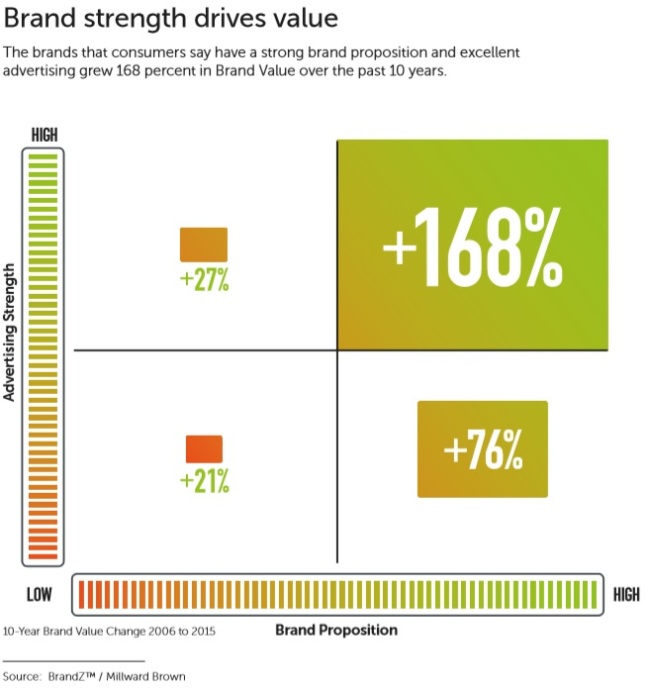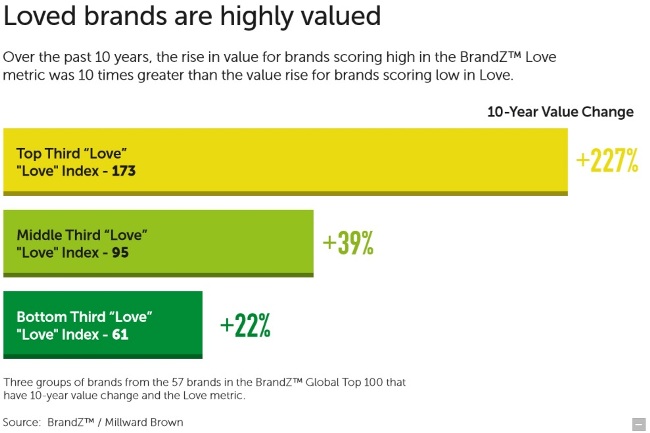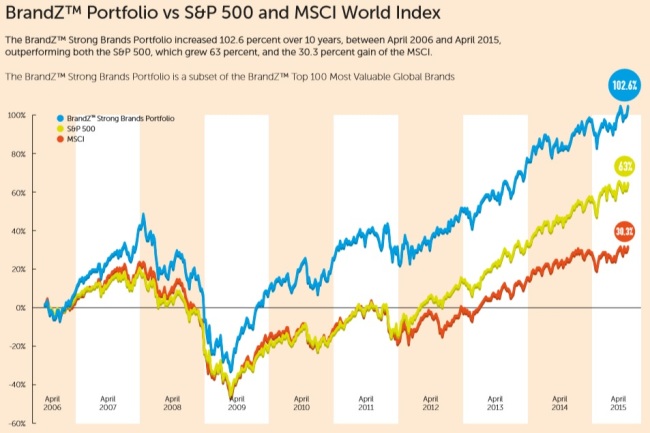Ten lessons from a decade of BrandZ
Stephen Whiteside
Warc
In each of the last ten years, Millward Brown – the research agency owned by WPP Group – has identified the 100 most valuable brands around the world in its annual "BrandZ" report.
According to Doreen Wang, global head/BrandZ, the insights it has gathered over the course of a decade have given rise to the "largest brand equity database worldwide". More specifically, this resource now spans:
- 100,000+ brands
- 400 categories
- 50 markets
- 4.5 billion data points
- Three million consumers
A high-level analysis of these statistics revealed that, despite the financial crisis starting in 2008/09, the collective net worth of the 100 brands which featured in the rankings rose by 126% between 2006 and 2015, reaching $3.3 trillion overall.
Wang, however, drilled significantly deeper into the BrandZ figures to establish some longer-term context for marketers, as well as to provide some actionable strategic advice for the future. Underpinning this endeavour, she suggested, was an attempt to answer a simple, albeit powerful, question: "What did the strong brands do right?"

Tackling this conundrum ultimately yielded ten tactics that could help distinguish tomorrow's brand leaders from the laggards – and which Wang shared with delegates attending the BrandZ Top 100 Most Valuable Global Brands Round Table event in New York.
Be different
Her first recommendation will be equally intuitive and challenging for brands as they struggle for recognition in increasingly cluttered and competitive industries. "In a world of so much product sameness, being different makes the difference," she said.
Using an average reading from 2006 to 2015, Millward Brown found the top 50 members of its BrandZ research posted a "difference" score of 139 points and saw their value leap by 124%. The bottom 50, in contrast, logged ratings of 96 points and 24% on the same measures respectively.
The main factors considered important by consumers when judging "difference" include creativity, trustworthiness and being "in control". Apple, for Wang, is perhaps the "ultimate example" of a brand which has obtained this kind of "meaningful difference", having excelled in all these areas and seen its value swell by 1,446% to $247 billion in the last ten years.
Have a purpose
Expanding on this notion, she stated that formulating and implementing a brand "purpose" that enriches the lives of consumers – a model favoured by companies like Unilever and General Mills – can pay off at a time when functional and emotional benefits are becoming "harder and harder" to identify and leverage.

"Being different is not for the sake of difference. Difference needs to correspond to the brand proposition," she said. "Brands with a strong purpose help accelerate brand equity. Those brands with a purpose which is beyond making money: they understand why they exist, how to improve consumers' lives and how to make the world a better place. These are the brands that achieve faster value growth."
Strong advertising
As the importance of brand purpose indicates, arriving at a clear, impactful positioning must be the primary objective for marketers. But, Wang argued, such a stance cannot ultimately make the desired impression on the target audience unless it is supported by "strong advertising".
Millward Brown's figures illustrated how this principle has translated into practice during the ten years since it began publishing its BrandZ reports – and that a compelling proposition backed by stimulating communications will pay real dividends.

Innovate for success
Brands that are regarded as being innovative enjoy similar advantages, largely because shoppers believe they are different and lead their industries. These operators typically excel in identifying unmet customer needs and display a willingness to take calculated risks – often then reaping the rewards.

Facebook, Apple and Intel represent a few of the best-placed players on this metric at present, Wang noted. "Many of these brands are from the technology industry, but we also see that a brand like Chipotle – which redefined the fast-food industry, and emphasised food integrity – being seen as setting trends," she added.
The value of love
Innovation requires a commitment to continuous improvement – and fostering consumer "love" should be another ongoing priority for marketers. "We understand that social [media] and the internet are amplifying love or hate towards a brand. We understand a brand cannot survive on love alone, but love has a multiplier effect," said Wang.

Coca-Cola, Visa, Nike and Alibaba all boast such bonds with their clientele. "'Loved' brands come from across categories … but they have one thing in common: they look at the world from the point of view of the consumer. And these are the brands that are not only warm and friendly, but they are genuine. And they also deliver what they have promised," she posited.
"Because love in the digital era follows great performance [and] follows great experience."
Innovation and love
Just as a resonant brand proposition and superior advertising work better together, so do pioneering products and a proclivity towards enhancing consumer affection.
"Innovation and love are like food and wine: they separately drive brand value, and together they form this virtuous circle. The correlation is very high: the love and innovation correlation is 0.89," said Wang. "Even the most innovative brand has some slowdown time. Love is then crucial: it gives brands time until the next big wave of creative development."
Stock market growth
Should these proof points not be suitably persuasive, Wang gave her marketing colleagues more data with which to make their case in the boardroom by comparing the BrandZ top 100 against two vital stock market indices: the S&P 500 and MSCI. "Marketing is not a cost; marketing is an investment. And superior brands generate superior shareholder returns," she observed.

"During the economic downturn of 2008/09, both strong brands and average brands declined in value significantly. However, it only took the strong brands half a year – versus the average brand's three and a half years – to recover to the previous value … So, investing in strong brands is most important – and a long-term guarantee of financial success."
New challengers
The logic behind this investment is lent further weight when considering the changes to the BrandZ rankings since 2006. "Fifty-eight brands are still on the brands on the top 100 in 2015," said Wang. "In the meantime, 42 brands have been replaced by those new, and faster-growing brands. And many of those brands are coming from fast-growing markets: India, China, Brazil and Indonesia."
In the first BrandZ study, for instance, China Mobile was the sole representative from the country; today, fully 14 indigenous enterprises are present. Alibaba, the ecommerce giant, has even emerged as the world's most valuable retail brand, despite the fact its efforts to progress internationally have not yet reached a critical mass.
"We are seeing many of these brands are big in their home countries, but they are not truly globalised brands," Wang said. "But in the past five years, these local brands have grown extremely fast. And, in the next five-to-ten years, they will potentially become global competitors."
Ask key questions
Drawing on the various insights contained within the BrandZ data, she outlined three issues that any marketer should take time to ponder:
- "How can we, as brand builders, make people's lives better?"
- "Do our customers – do our consumers – really believe we care through [seeing] innovating and loving experiences?"
- How might brands attain "meaningful difference" in their home country and overseas?
Prepare for disruption
A final question, and one worthy of separate discussion, concerns the technological change which is transforming almost every industry – and that will cause the value of many assets to surge, while others witness rapid depreciations. "The technology explosion is making disruptive innovation happen," said Wang.
"As the most valuable brands, how can we get ourselves ready and embrace this disruptive innovation [and] continue to build the financially-successful, most-valuable brands in the next ten years?"

Stephen Whiteside is Warc's Reports Editor.

